MERR5030 - UK Environmental Policy Tools for Oil and Gas Industry
VerifiedAdded on 2023/06/04
|16
|3804
|221
Report
AI Summary
This report critically analyzes environmental regulatory policy tools, specifically carbon tax and cap and trade, used in the UK oil and gas industry to achieve environmental objectives. It evaluates the effectiveness of these instruments in mitigating climate change and managing energy resources. The report examines the challenges faced by the oil and gas industry, including declining tax revenues and rising decommissioning costs. It further assesses the implementation and impact of carbon tax and cap and trade systems in the UK, considering their advantages, disadvantages, and alignment with environmental targets, including the Paris Agreement. The report concludes by highlighting the importance of modifying the Carbon Price Support to become an economy-wide carbon tax for greater effectiveness.
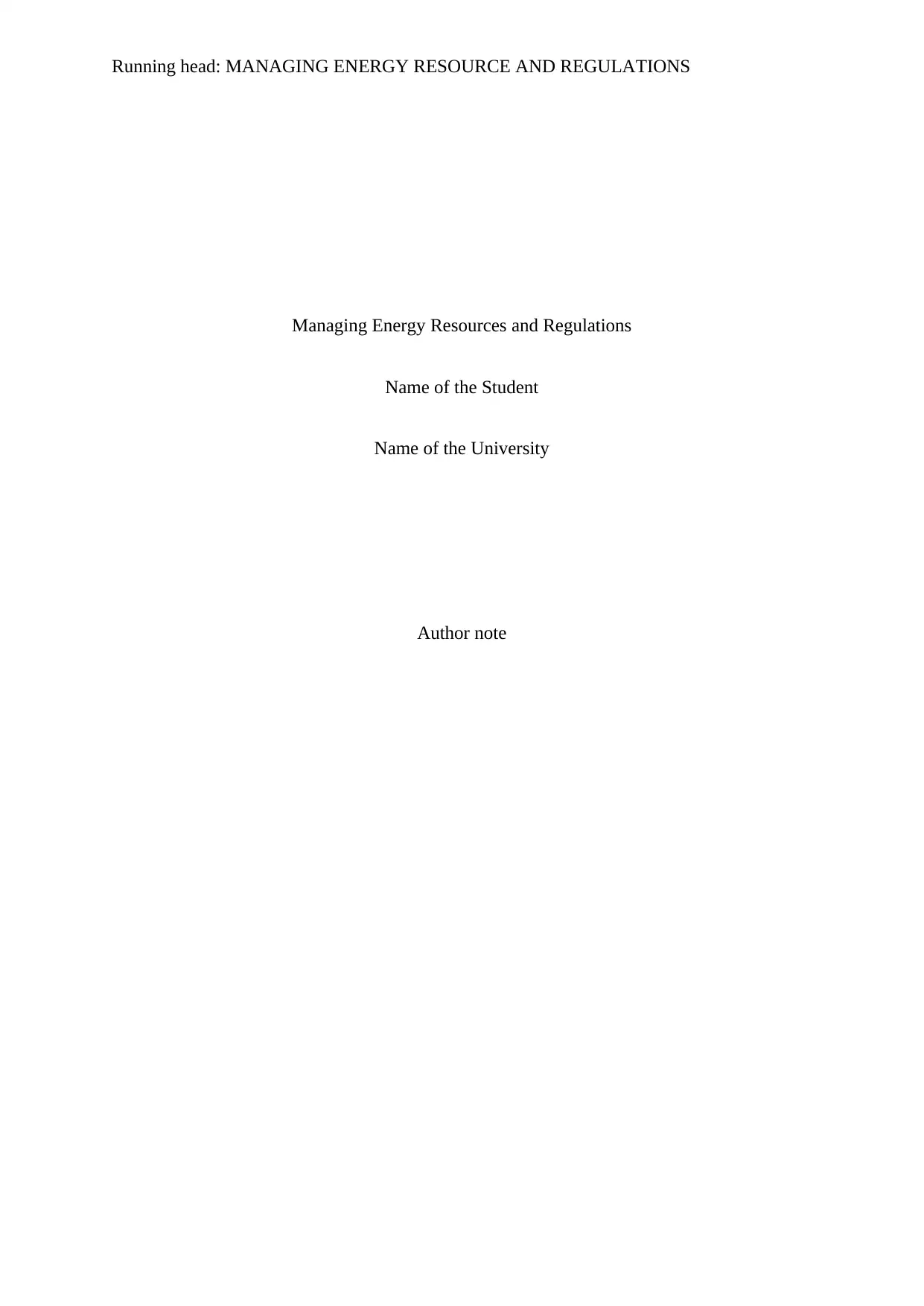
Running head: MANAGING ENERGY RESOURCE AND REGULATIONS
Managing Energy Resources and Regulations
Name of the Student
Name of the University
Author note
Managing Energy Resources and Regulations
Name of the Student
Name of the University
Author note
Paraphrase This Document
Need a fresh take? Get an instant paraphrase of this document with our AI Paraphraser
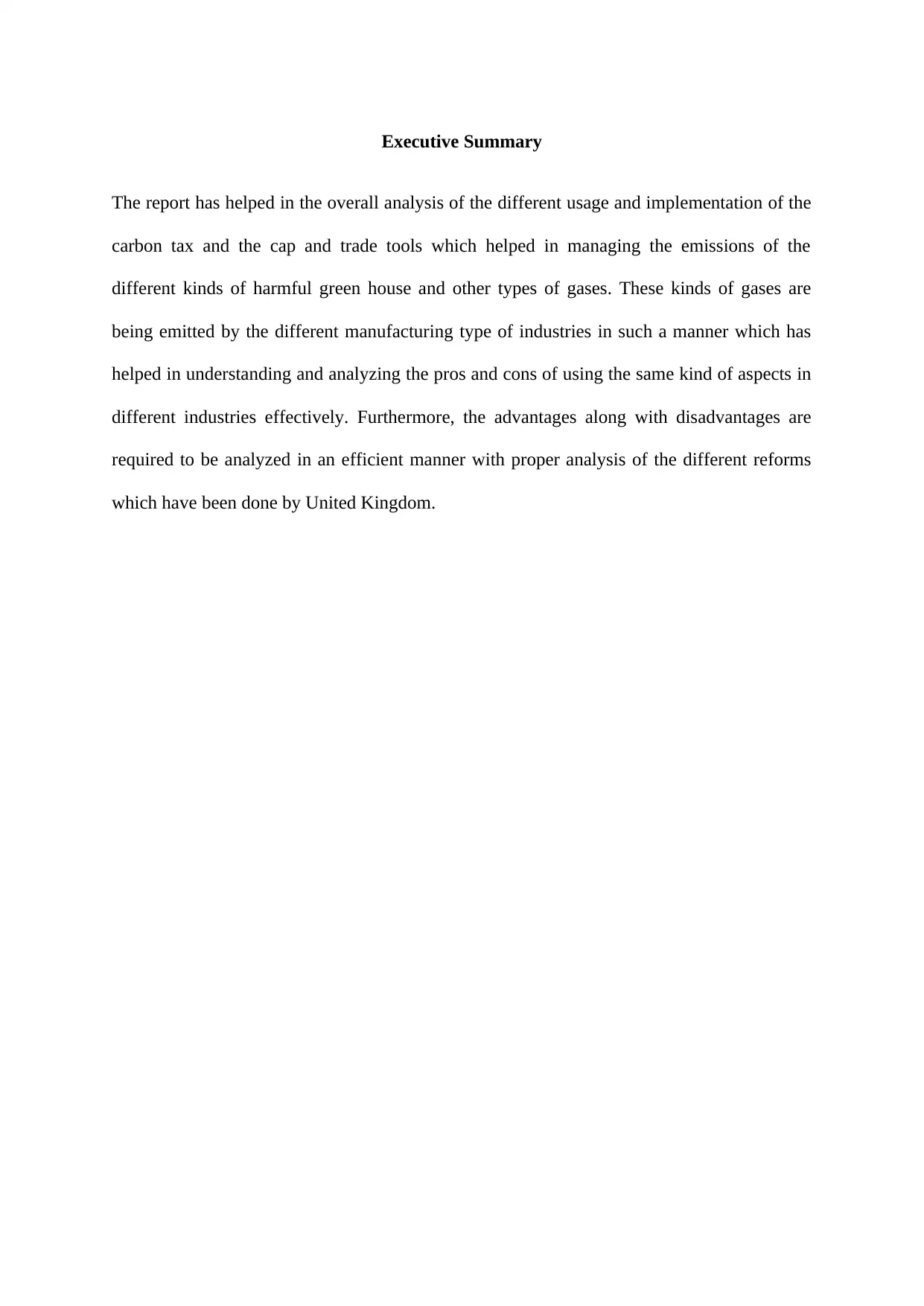
Executive Summary
The report has helped in the overall analysis of the different usage and implementation of the
carbon tax and the cap and trade tools which helped in managing the emissions of the
different kinds of harmful green house and other types of gases. These kinds of gases are
being emitted by the different manufacturing type of industries in such a manner which has
helped in understanding and analyzing the pros and cons of using the same kind of aspects in
different industries effectively. Furthermore, the advantages along with disadvantages are
required to be analyzed in an efficient manner with proper analysis of the different reforms
which have been done by United Kingdom.
The report has helped in the overall analysis of the different usage and implementation of the
carbon tax and the cap and trade tools which helped in managing the emissions of the
different kinds of harmful green house and other types of gases. These kinds of gases are
being emitted by the different manufacturing type of industries in such a manner which has
helped in understanding and analyzing the pros and cons of using the same kind of aspects in
different industries effectively. Furthermore, the advantages along with disadvantages are
required to be analyzed in an efficient manner with proper analysis of the different reforms
which have been done by United Kingdom.
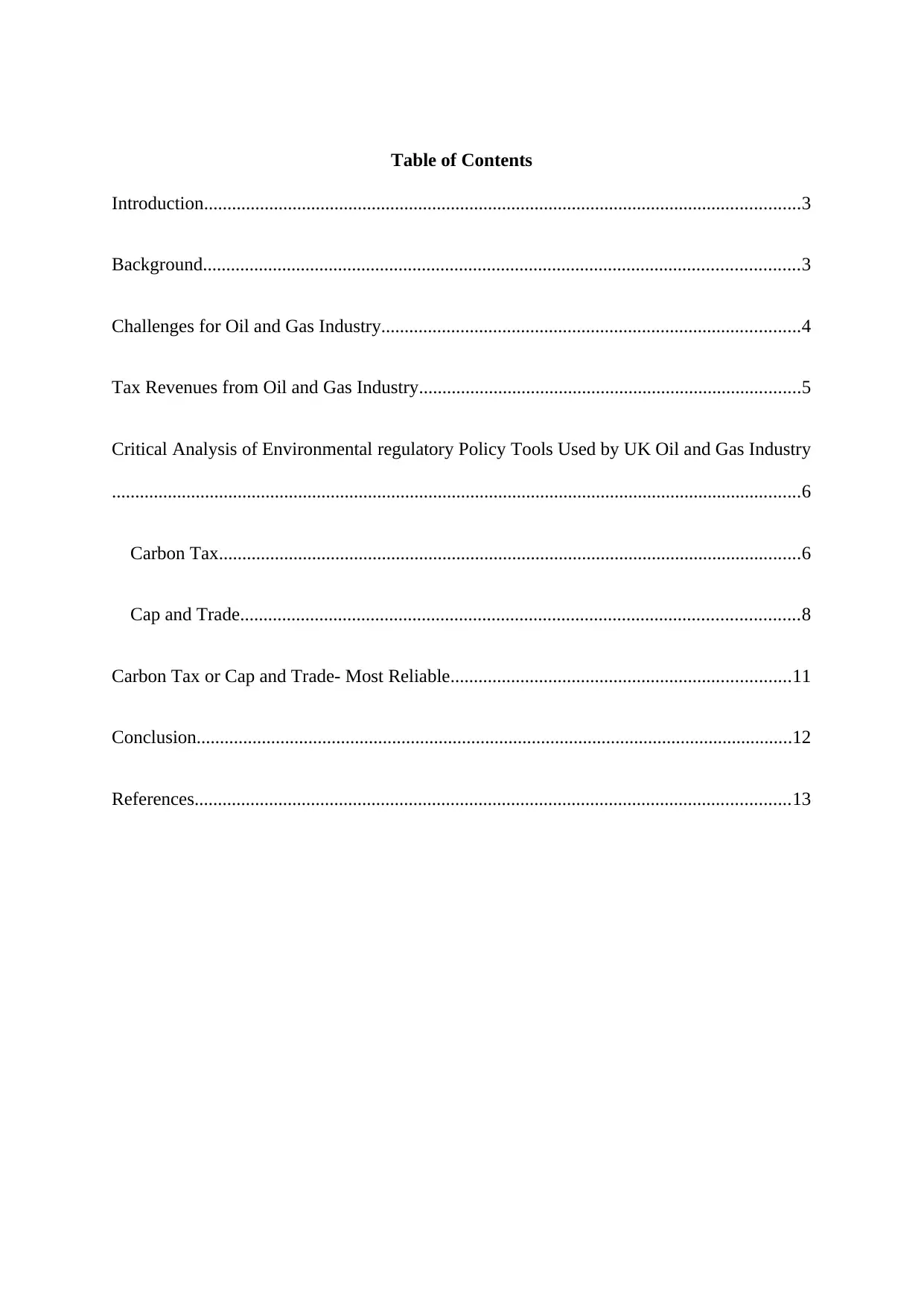
Table of Contents
Introduction................................................................................................................................3
Background................................................................................................................................3
Challenges for Oil and Gas Industry..........................................................................................4
Tax Revenues from Oil and Gas Industry..................................................................................5
Critical Analysis of Environmental regulatory Policy Tools Used by UK Oil and Gas Industry
....................................................................................................................................................6
Carbon Tax.............................................................................................................................6
Cap and Trade........................................................................................................................8
Carbon Tax or Cap and Trade- Most Reliable.........................................................................11
Conclusion................................................................................................................................12
References................................................................................................................................13
Introduction................................................................................................................................3
Background................................................................................................................................3
Challenges for Oil and Gas Industry..........................................................................................4
Tax Revenues from Oil and Gas Industry..................................................................................5
Critical Analysis of Environmental regulatory Policy Tools Used by UK Oil and Gas Industry
....................................................................................................................................................6
Carbon Tax.............................................................................................................................6
Cap and Trade........................................................................................................................8
Carbon Tax or Cap and Trade- Most Reliable.........................................................................11
Conclusion................................................................................................................................12
References................................................................................................................................13
⊘ This is a preview!⊘
Do you want full access?
Subscribe today to unlock all pages.

Trusted by 1+ million students worldwide
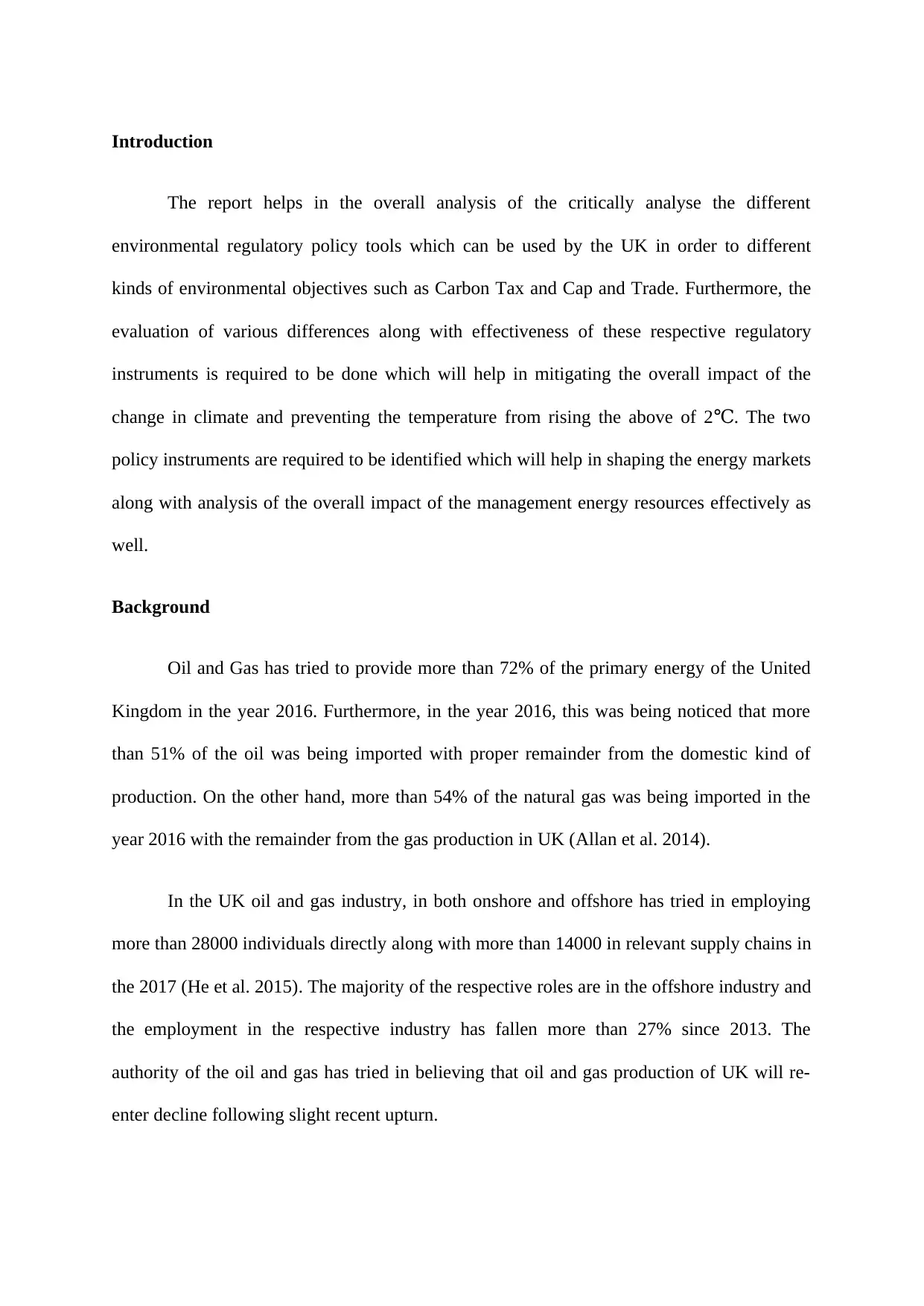
Introduction
The report helps in the overall analysis of the critically analyse the different
environmental regulatory policy tools which can be used by the UK in order to different
kinds of environmental objectives such as Carbon Tax and Cap and Trade. Furthermore, the
evaluation of various differences along with effectiveness of these respective regulatory
instruments is required to be done which will help in mitigating the overall impact of the
change in climate and preventing the temperature from rising the above of 2 . The two℃
policy instruments are required to be identified which will help in shaping the energy markets
along with analysis of the overall impact of the management energy resources effectively as
well.
Background
Oil and Gas has tried to provide more than 72% of the primary energy of the United
Kingdom in the year 2016. Furthermore, in the year 2016, this was being noticed that more
than 51% of the oil was being imported with proper remainder from the domestic kind of
production. On the other hand, more than 54% of the natural gas was being imported in the
year 2016 with the remainder from the gas production in UK (Allan et al. 2014).
In the UK oil and gas industry, in both onshore and offshore has tried in employing
more than 28000 individuals directly along with more than 14000 in relevant supply chains in
the 2017 (He et al. 2015). The majority of the respective roles are in the offshore industry and
the employment in the respective industry has fallen more than 27% since 2013. The
authority of the oil and gas has tried in believing that oil and gas production of UK will re-
enter decline following slight recent upturn.
The report helps in the overall analysis of the critically analyse the different
environmental regulatory policy tools which can be used by the UK in order to different
kinds of environmental objectives such as Carbon Tax and Cap and Trade. Furthermore, the
evaluation of various differences along with effectiveness of these respective regulatory
instruments is required to be done which will help in mitigating the overall impact of the
change in climate and preventing the temperature from rising the above of 2 . The two℃
policy instruments are required to be identified which will help in shaping the energy markets
along with analysis of the overall impact of the management energy resources effectively as
well.
Background
Oil and Gas has tried to provide more than 72% of the primary energy of the United
Kingdom in the year 2016. Furthermore, in the year 2016, this was being noticed that more
than 51% of the oil was being imported with proper remainder from the domestic kind of
production. On the other hand, more than 54% of the natural gas was being imported in the
year 2016 with the remainder from the gas production in UK (Allan et al. 2014).
In the UK oil and gas industry, in both onshore and offshore has tried in employing
more than 28000 individuals directly along with more than 14000 in relevant supply chains in
the 2017 (He et al. 2015). The majority of the respective roles are in the offshore industry and
the employment in the respective industry has fallen more than 27% since 2013. The
authority of the oil and gas has tried in believing that oil and gas production of UK will re-
enter decline following slight recent upturn.
Paraphrase This Document
Need a fresh take? Get an instant paraphrase of this document with our AI Paraphraser
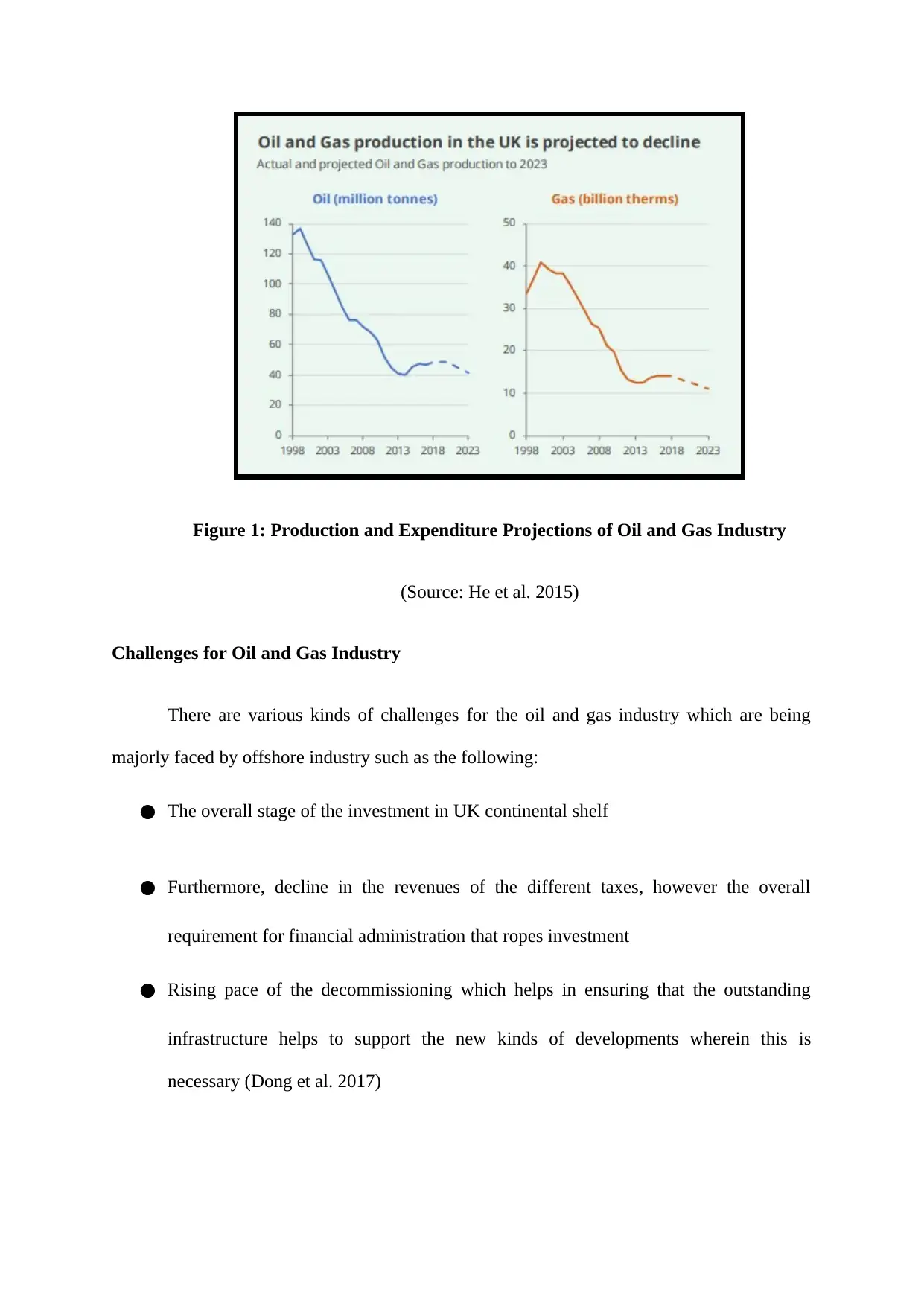
Figure 1: Production and Expenditure Projections of Oil and Gas Industry
(Source: He et al. 2015)
Challenges for Oil and Gas Industry
There are various kinds of challenges for the oil and gas industry which are being
majorly faced by offshore industry such as the following:
● The overall stage of the investment in UK continental shelf
● Furthermore, decline in the revenues of the different taxes, however the overall
requirement for financial administration that ropes investment
● Rising pace of the decommissioning which helps in ensuring that the outstanding
infrastructure helps to support the new kinds of developments wherein this is
necessary (Dong et al. 2017)
(Source: He et al. 2015)
Challenges for Oil and Gas Industry
There are various kinds of challenges for the oil and gas industry which are being
majorly faced by offshore industry such as the following:
● The overall stage of the investment in UK continental shelf
● Furthermore, decline in the revenues of the different taxes, however the overall
requirement for financial administration that ropes investment
● Rising pace of the decommissioning which helps in ensuring that the outstanding
infrastructure helps to support the new kinds of developments wherein this is
necessary (Dong et al. 2017)
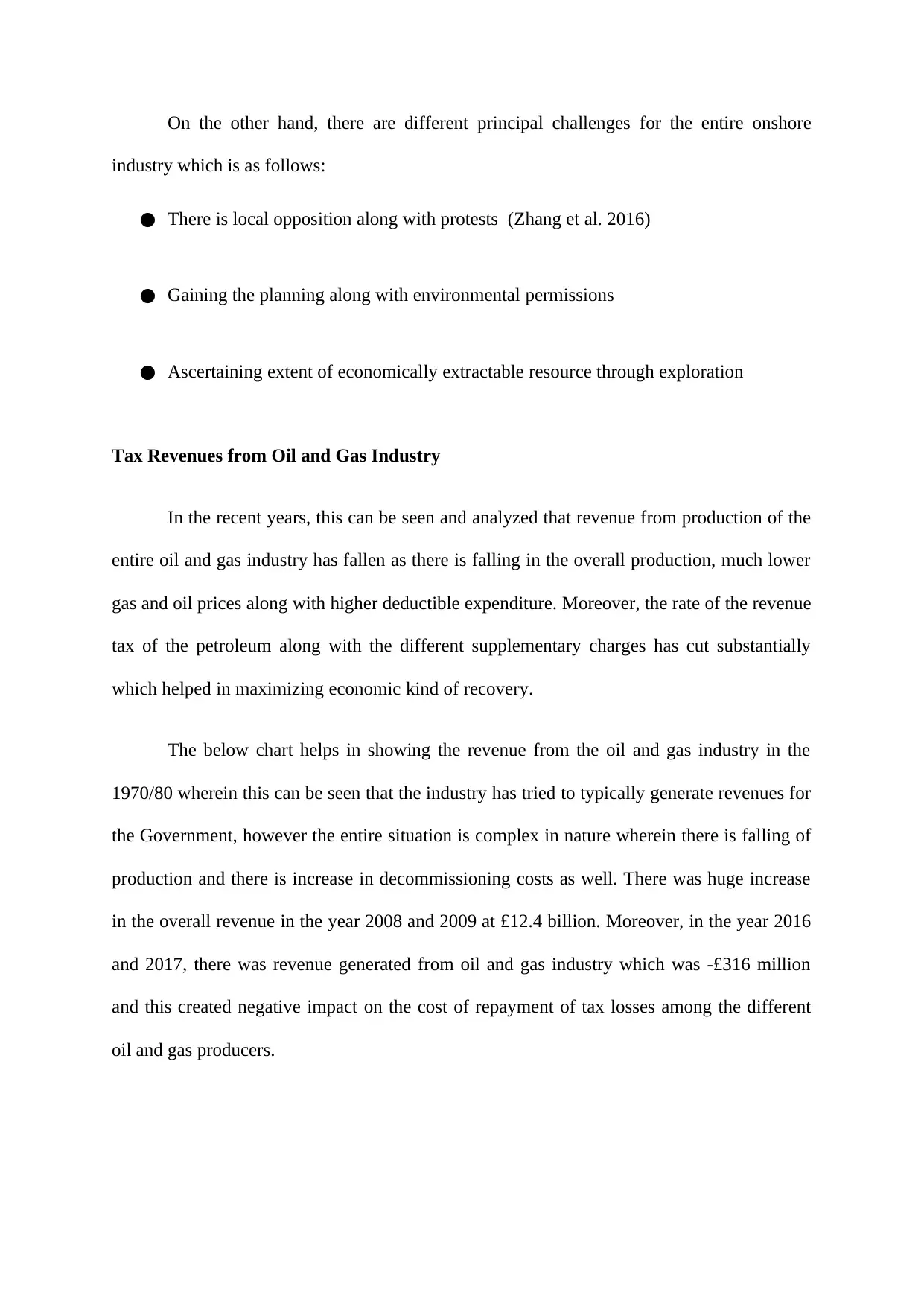
On the other hand, there are different principal challenges for the entire onshore
industry which is as follows:
● There is local opposition along with protests (Zhang et al. 2016)
● Gaining the planning along with environmental permissions
● Ascertaining extent of economically extractable resource through exploration
Tax Revenues from Oil and Gas Industry
In the recent years, this can be seen and analyzed that revenue from production of the
entire oil and gas industry has fallen as there is falling in the overall production, much lower
gas and oil prices along with higher deductible expenditure. Moreover, the rate of the revenue
tax of the petroleum along with the different supplementary charges has cut substantially
which helped in maximizing economic kind of recovery.
The below chart helps in showing the revenue from the oil and gas industry in the
1970/80 wherein this can be seen that the industry has tried to typically generate revenues for
the Government, however the entire situation is complex in nature wherein there is falling of
production and there is increase in decommissioning costs as well. There was huge increase
in the overall revenue in the year 2008 and 2009 at £12.4 billion. Moreover, in the year 2016
and 2017, there was revenue generated from oil and gas industry which was -£316 million
and this created negative impact on the cost of repayment of tax losses among the different
oil and gas producers.
industry which is as follows:
● There is local opposition along with protests (Zhang et al. 2016)
● Gaining the planning along with environmental permissions
● Ascertaining extent of economically extractable resource through exploration
Tax Revenues from Oil and Gas Industry
In the recent years, this can be seen and analyzed that revenue from production of the
entire oil and gas industry has fallen as there is falling in the overall production, much lower
gas and oil prices along with higher deductible expenditure. Moreover, the rate of the revenue
tax of the petroleum along with the different supplementary charges has cut substantially
which helped in maximizing economic kind of recovery.
The below chart helps in showing the revenue from the oil and gas industry in the
1970/80 wherein this can be seen that the industry has tried to typically generate revenues for
the Government, however the entire situation is complex in nature wherein there is falling of
production and there is increase in decommissioning costs as well. There was huge increase
in the overall revenue in the year 2008 and 2009 at £12.4 billion. Moreover, in the year 2016
and 2017, there was revenue generated from oil and gas industry which was -£316 million
and this created negative impact on the cost of repayment of tax losses among the different
oil and gas producers.
⊘ This is a preview!⊘
Do you want full access?
Subscribe today to unlock all pages.

Trusted by 1+ million students worldwide
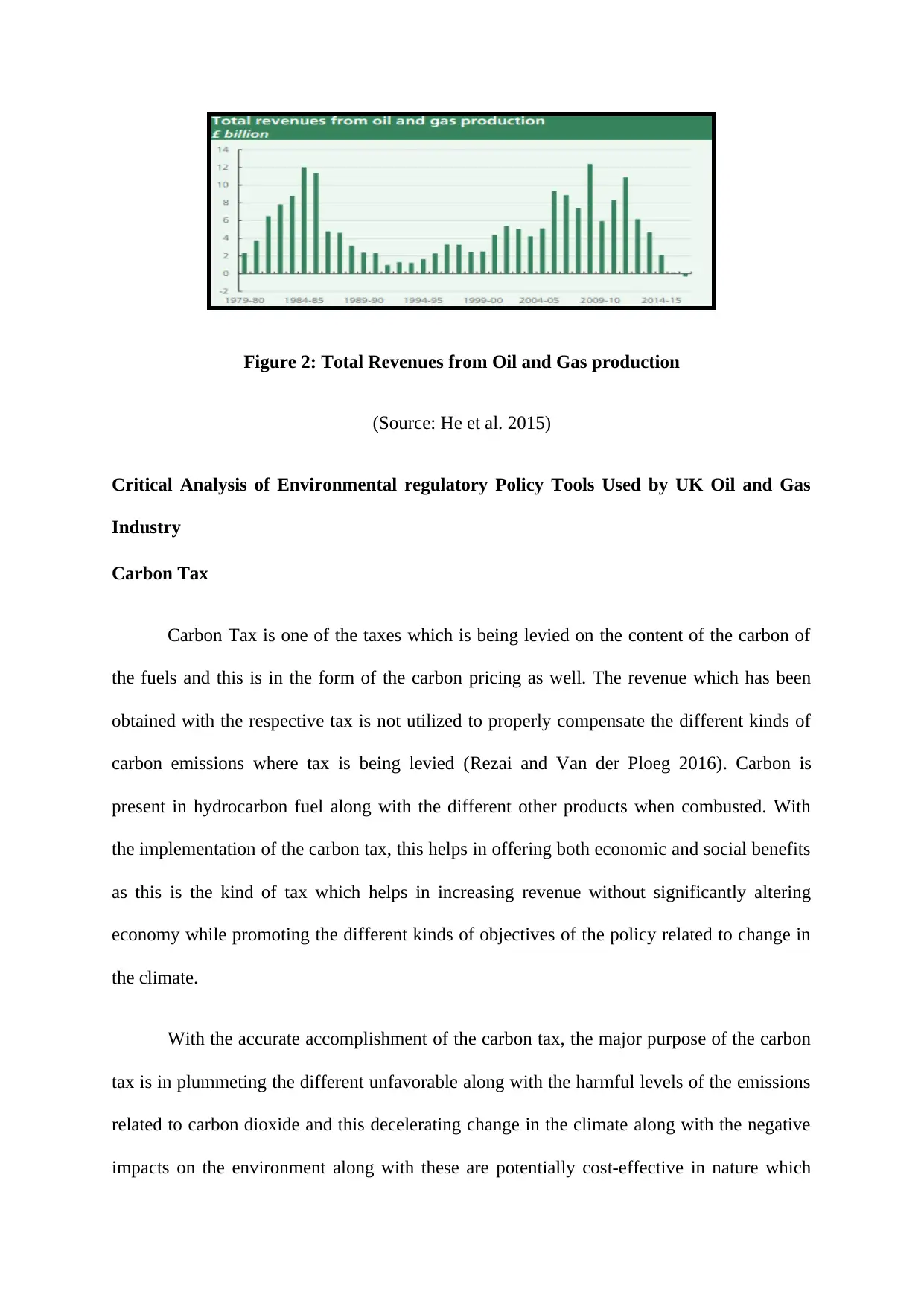
Figure 2: Total Revenues from Oil and Gas production
(Source: He et al. 2015)
Critical Analysis of Environmental regulatory Policy Tools Used by UK Oil and Gas
Industry
Carbon Tax
Carbon Tax is one of the taxes which is being levied on the content of the carbon of
the fuels and this is in the form of the carbon pricing as well. The revenue which has been
obtained with the respective tax is not utilized to properly compensate the different kinds of
carbon emissions where tax is being levied (Rezai and Van der Ploeg 2016). Carbon is
present in hydrocarbon fuel along with the different other products when combusted. With
the implementation of the carbon tax, this helps in offering both economic and social benefits
as this is the kind of tax which helps in increasing revenue without significantly altering
economy while promoting the different kinds of objectives of the policy related to change in
the climate.
With the accurate accomplishment of the carbon tax, the major purpose of the carbon
tax is in plummeting the different unfavorable along with the harmful levels of the emissions
related to carbon dioxide and this decelerating change in the climate along with the negative
impacts on the environment along with these are potentially cost-effective in nature which
(Source: He et al. 2015)
Critical Analysis of Environmental regulatory Policy Tools Used by UK Oil and Gas
Industry
Carbon Tax
Carbon Tax is one of the taxes which is being levied on the content of the carbon of
the fuels and this is in the form of the carbon pricing as well. The revenue which has been
obtained with the respective tax is not utilized to properly compensate the different kinds of
carbon emissions where tax is being levied (Rezai and Van der Ploeg 2016). Carbon is
present in hydrocarbon fuel along with the different other products when combusted. With
the implementation of the carbon tax, this helps in offering both economic and social benefits
as this is the kind of tax which helps in increasing revenue without significantly altering
economy while promoting the different kinds of objectives of the policy related to change in
the climate.
With the accurate accomplishment of the carbon tax, the major purpose of the carbon
tax is in plummeting the different unfavorable along with the harmful levels of the emissions
related to carbon dioxide and this decelerating change in the climate along with the negative
impacts on the environment along with these are potentially cost-effective in nature which
Paraphrase This Document
Need a fresh take? Get an instant paraphrase of this document with our AI Paraphraser
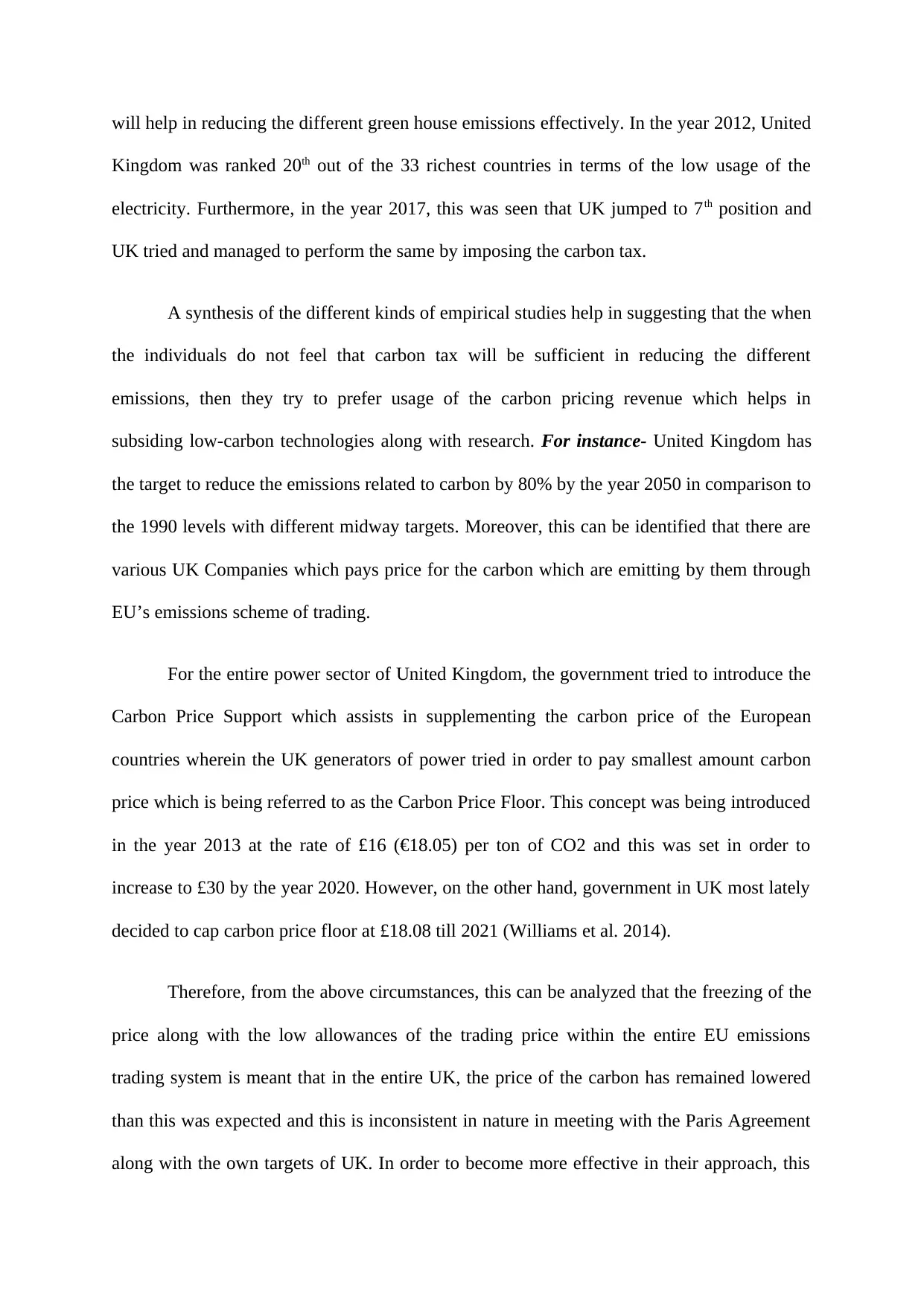
will help in reducing the different green house emissions effectively. In the year 2012, United
Kingdom was ranked 20th out of the 33 richest countries in terms of the low usage of the
electricity. Furthermore, in the year 2017, this was seen that UK jumped to 7th position and
UK tried and managed to perform the same by imposing the carbon tax.
A synthesis of the different kinds of empirical studies help in suggesting that the when
the individuals do not feel that carbon tax will be sufficient in reducing the different
emissions, then they try to prefer usage of the carbon pricing revenue which helps in
subsiding low-carbon technologies along with research. For instance- United Kingdom has
the target to reduce the emissions related to carbon by 80% by the year 2050 in comparison to
the 1990 levels with different midway targets. Moreover, this can be identified that there are
various UK Companies which pays price for the carbon which are emitting by them through
EU’s emissions scheme of trading.
For the entire power sector of United Kingdom, the government tried to introduce the
Carbon Price Support which assists in supplementing the carbon price of the European
countries wherein the UK generators of power tried in order to pay smallest amount carbon
price which is being referred to as the Carbon Price Floor. This concept was being introduced
in the year 2013 at the rate of £16 (€18.05) per ton of CO2 and this was set in order to
increase to £30 by the year 2020. However, on the other hand, government in UK most lately
decided to cap carbon price floor at £18.08 till 2021 (Williams et al. 2014).
Therefore, from the above circumstances, this can be analyzed that the freezing of the
price along with the low allowances of the trading price within the entire EU emissions
trading system is meant that in the entire UK, the price of the carbon has remained lowered
than this was expected and this is inconsistent in nature in meeting with the Paris Agreement
along with the own targets of UK. In order to become more effective in their approach, this
Kingdom was ranked 20th out of the 33 richest countries in terms of the low usage of the
electricity. Furthermore, in the year 2017, this was seen that UK jumped to 7th position and
UK tried and managed to perform the same by imposing the carbon tax.
A synthesis of the different kinds of empirical studies help in suggesting that the when
the individuals do not feel that carbon tax will be sufficient in reducing the different
emissions, then they try to prefer usage of the carbon pricing revenue which helps in
subsiding low-carbon technologies along with research. For instance- United Kingdom has
the target to reduce the emissions related to carbon by 80% by the year 2050 in comparison to
the 1990 levels with different midway targets. Moreover, this can be identified that there are
various UK Companies which pays price for the carbon which are emitting by them through
EU’s emissions scheme of trading.
For the entire power sector of United Kingdom, the government tried to introduce the
Carbon Price Support which assists in supplementing the carbon price of the European
countries wherein the UK generators of power tried in order to pay smallest amount carbon
price which is being referred to as the Carbon Price Floor. This concept was being introduced
in the year 2013 at the rate of £16 (€18.05) per ton of CO2 and this was set in order to
increase to £30 by the year 2020. However, on the other hand, government in UK most lately
decided to cap carbon price floor at £18.08 till 2021 (Williams et al. 2014).
Therefore, from the above circumstances, this can be analyzed that the freezing of the
price along with the low allowances of the trading price within the entire EU emissions
trading system is meant that in the entire UK, the price of the carbon has remained lowered
than this was expected and this is inconsistent in nature in meeting with the Paris Agreement
along with the own targets of UK. In order to become more effective in their approach, this
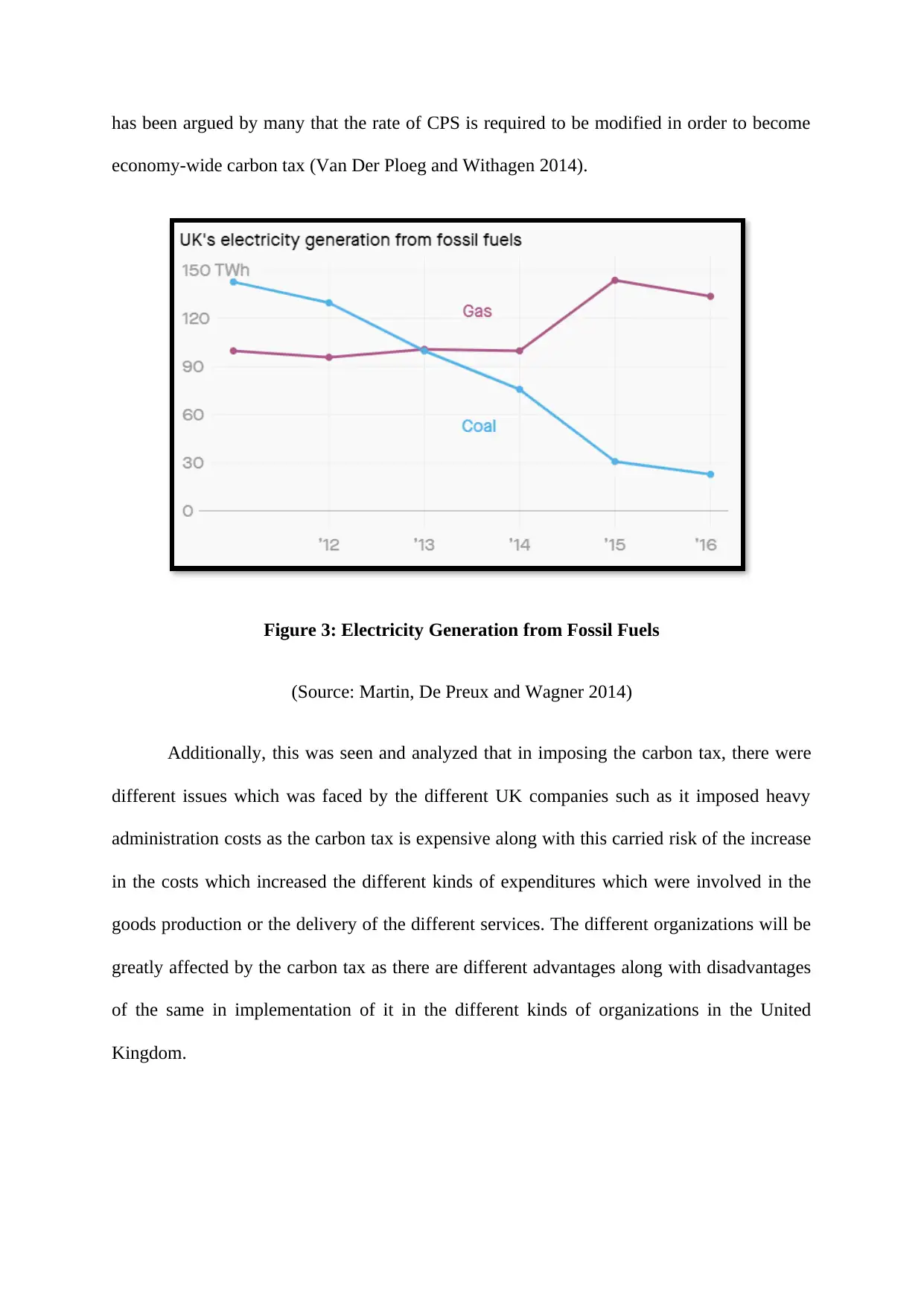
has been argued by many that the rate of CPS is required to be modified in order to become
economy-wide carbon tax (Van Der Ploeg and Withagen 2014).
Figure 3: Electricity Generation from Fossil Fuels
(Source: Martin, De Preux and Wagner 2014)
Additionally, this was seen and analyzed that in imposing the carbon tax, there were
different issues which was faced by the different UK companies such as it imposed heavy
administration costs as the carbon tax is expensive along with this carried risk of the increase
in the costs which increased the different kinds of expenditures which were involved in the
goods production or the delivery of the different services. The different organizations will be
greatly affected by the carbon tax as there are different advantages along with disadvantages
of the same in implementation of it in the different kinds of organizations in the United
Kingdom.
economy-wide carbon tax (Van Der Ploeg and Withagen 2014).
Figure 3: Electricity Generation from Fossil Fuels
(Source: Martin, De Preux and Wagner 2014)
Additionally, this was seen and analyzed that in imposing the carbon tax, there were
different issues which was faced by the different UK companies such as it imposed heavy
administration costs as the carbon tax is expensive along with this carried risk of the increase
in the costs which increased the different kinds of expenditures which were involved in the
goods production or the delivery of the different services. The different organizations will be
greatly affected by the carbon tax as there are different advantages along with disadvantages
of the same in implementation of it in the different kinds of organizations in the United
Kingdom.
⊘ This is a preview!⊘
Do you want full access?
Subscribe today to unlock all pages.

Trusted by 1+ million students worldwide
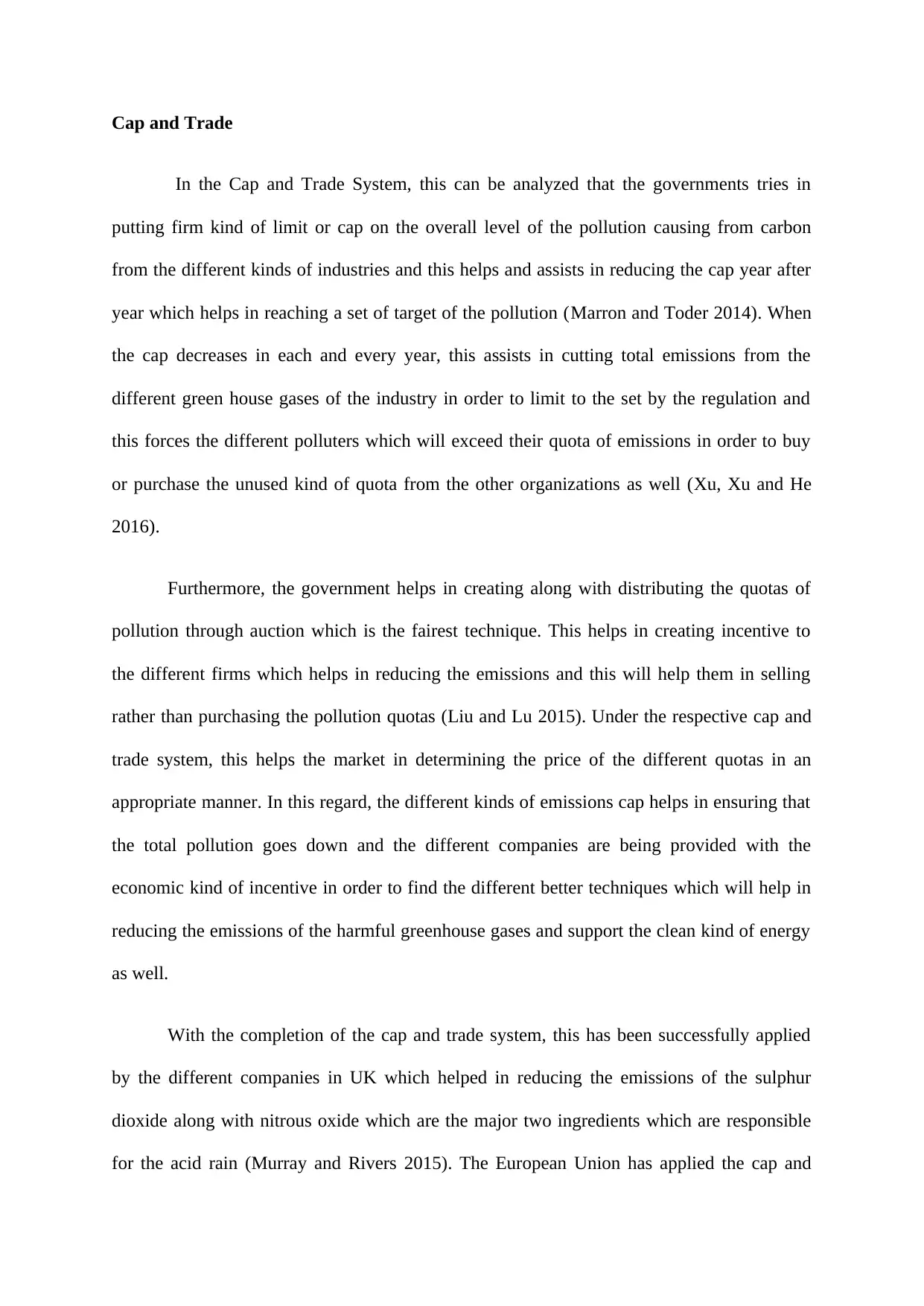
Cap and Trade
In the Cap and Trade System, this can be analyzed that the governments tries in
putting firm kind of limit or cap on the overall level of the pollution causing from carbon
from the different kinds of industries and this helps and assists in reducing the cap year after
year which helps in reaching a set of target of the pollution (Marron and Toder 2014). When
the cap decreases in each and every year, this assists in cutting total emissions from the
different green house gases of the industry in order to limit to the set by the regulation and
this forces the different polluters which will exceed their quota of emissions in order to buy
or purchase the unused kind of quota from the other organizations as well (Xu, Xu and He
2016).
Furthermore, the government helps in creating along with distributing the quotas of
pollution through auction which is the fairest technique. This helps in creating incentive to
the different firms which helps in reducing the emissions and this will help them in selling
rather than purchasing the pollution quotas (Liu and Lu 2015). Under the respective cap and
trade system, this helps the market in determining the price of the different quotas in an
appropriate manner. In this regard, the different kinds of emissions cap helps in ensuring that
the total pollution goes down and the different companies are being provided with the
economic kind of incentive in order to find the different better techniques which will help in
reducing the emissions of the harmful greenhouse gases and support the clean kind of energy
as well.
With the completion of the cap and trade system, this has been successfully applied
by the different companies in UK which helped in reducing the emissions of the sulphur
dioxide along with nitrous oxide which are the major two ingredients which are responsible
for the acid rain (Murray and Rivers 2015). The European Union has applied the cap and
In the Cap and Trade System, this can be analyzed that the governments tries in
putting firm kind of limit or cap on the overall level of the pollution causing from carbon
from the different kinds of industries and this helps and assists in reducing the cap year after
year which helps in reaching a set of target of the pollution (Marron and Toder 2014). When
the cap decreases in each and every year, this assists in cutting total emissions from the
different green house gases of the industry in order to limit to the set by the regulation and
this forces the different polluters which will exceed their quota of emissions in order to buy
or purchase the unused kind of quota from the other organizations as well (Xu, Xu and He
2016).
Furthermore, the government helps in creating along with distributing the quotas of
pollution through auction which is the fairest technique. This helps in creating incentive to
the different firms which helps in reducing the emissions and this will help them in selling
rather than purchasing the pollution quotas (Liu and Lu 2015). Under the respective cap and
trade system, this helps the market in determining the price of the different quotas in an
appropriate manner. In this regard, the different kinds of emissions cap helps in ensuring that
the total pollution goes down and the different companies are being provided with the
economic kind of incentive in order to find the different better techniques which will help in
reducing the emissions of the harmful greenhouse gases and support the clean kind of energy
as well.
With the completion of the cap and trade system, this has been successfully applied
by the different companies in UK which helped in reducing the emissions of the sulphur
dioxide along with nitrous oxide which are the major two ingredients which are responsible
for the acid rain (Murray and Rivers 2015). The European Union has applied the cap and
Paraphrase This Document
Need a fresh take? Get an instant paraphrase of this document with our AI Paraphraser
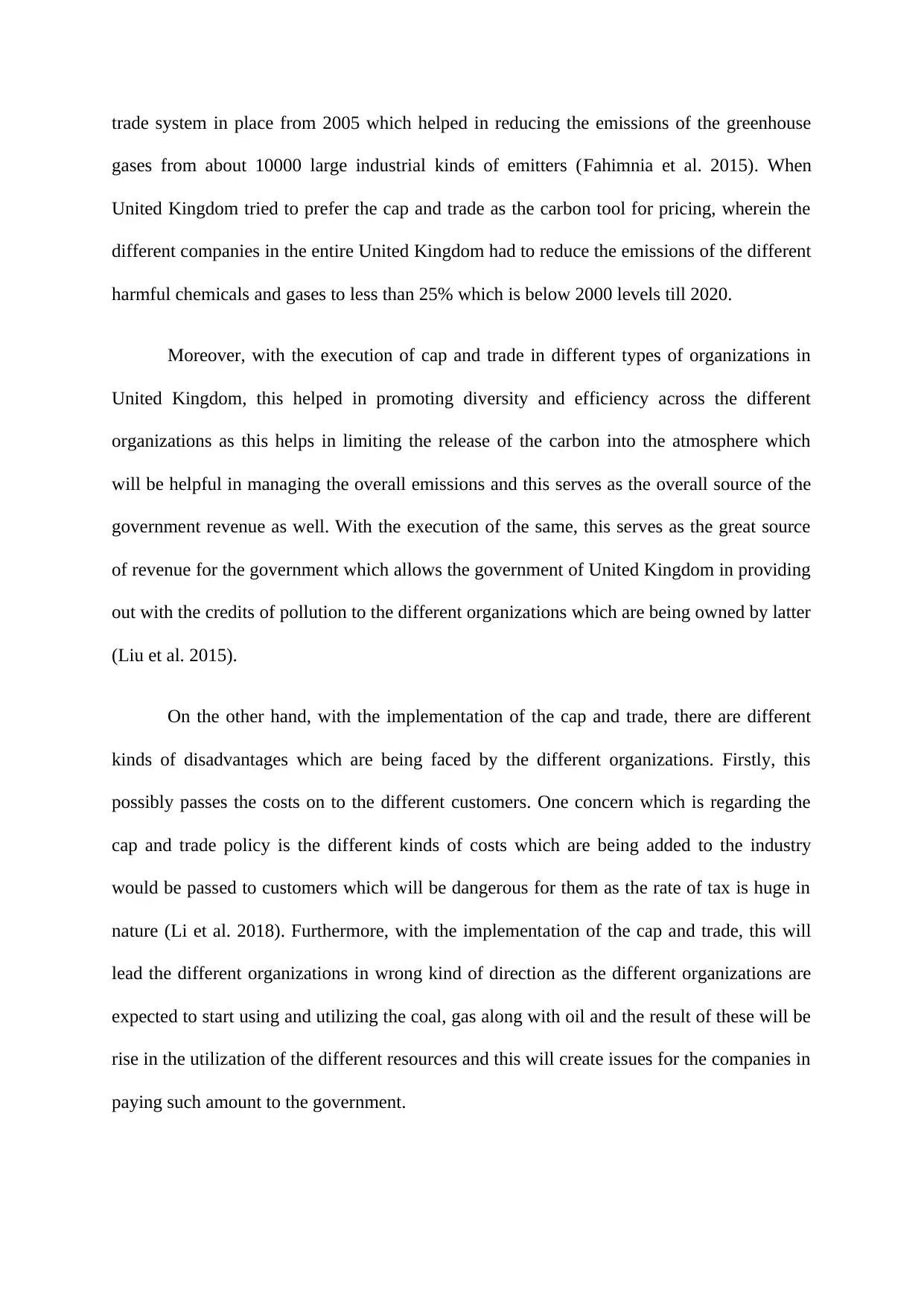
trade system in place from 2005 which helped in reducing the emissions of the greenhouse
gases from about 10000 large industrial kinds of emitters (Fahimnia et al. 2015). When
United Kingdom tried to prefer the cap and trade as the carbon tool for pricing, wherein the
different companies in the entire United Kingdom had to reduce the emissions of the different
harmful chemicals and gases to less than 25% which is below 2000 levels till 2020.
Moreover, with the execution of cap and trade in different types of organizations in
United Kingdom, this helped in promoting diversity and efficiency across the different
organizations as this helps in limiting the release of the carbon into the atmosphere which
will be helpful in managing the overall emissions and this serves as the overall source of the
government revenue as well. With the execution of the same, this serves as the great source
of revenue for the government which allows the government of United Kingdom in providing
out with the credits of pollution to the different organizations which are being owned by latter
(Liu et al. 2015).
On the other hand, with the implementation of the cap and trade, there are different
kinds of disadvantages which are being faced by the different organizations. Firstly, this
possibly passes the costs on to the different customers. One concern which is regarding the
cap and trade policy is the different kinds of costs which are being added to the industry
would be passed to customers which will be dangerous for them as the rate of tax is huge in
nature (Li et al. 2018). Furthermore, with the implementation of the cap and trade, this will
lead the different organizations in wrong kind of direction as the different organizations are
expected to start using and utilizing the coal, gas along with oil and the result of these will be
rise in the utilization of the different resources and this will create issues for the companies in
paying such amount to the government.
gases from about 10000 large industrial kinds of emitters (Fahimnia et al. 2015). When
United Kingdom tried to prefer the cap and trade as the carbon tool for pricing, wherein the
different companies in the entire United Kingdom had to reduce the emissions of the different
harmful chemicals and gases to less than 25% which is below 2000 levels till 2020.
Moreover, with the execution of cap and trade in different types of organizations in
United Kingdom, this helped in promoting diversity and efficiency across the different
organizations as this helps in limiting the release of the carbon into the atmosphere which
will be helpful in managing the overall emissions and this serves as the overall source of the
government revenue as well. With the execution of the same, this serves as the great source
of revenue for the government which allows the government of United Kingdom in providing
out with the credits of pollution to the different organizations which are being owned by latter
(Liu et al. 2015).
On the other hand, with the implementation of the cap and trade, there are different
kinds of disadvantages which are being faced by the different organizations. Firstly, this
possibly passes the costs on to the different customers. One concern which is regarding the
cap and trade policy is the different kinds of costs which are being added to the industry
would be passed to customers which will be dangerous for them as the rate of tax is huge in
nature (Li et al. 2018). Furthermore, with the implementation of the cap and trade, this will
lead the different organizations in wrong kind of direction as the different organizations are
expected to start using and utilizing the coal, gas along with oil and the result of these will be
rise in the utilization of the different resources and this will create issues for the companies in
paying such amount to the government.
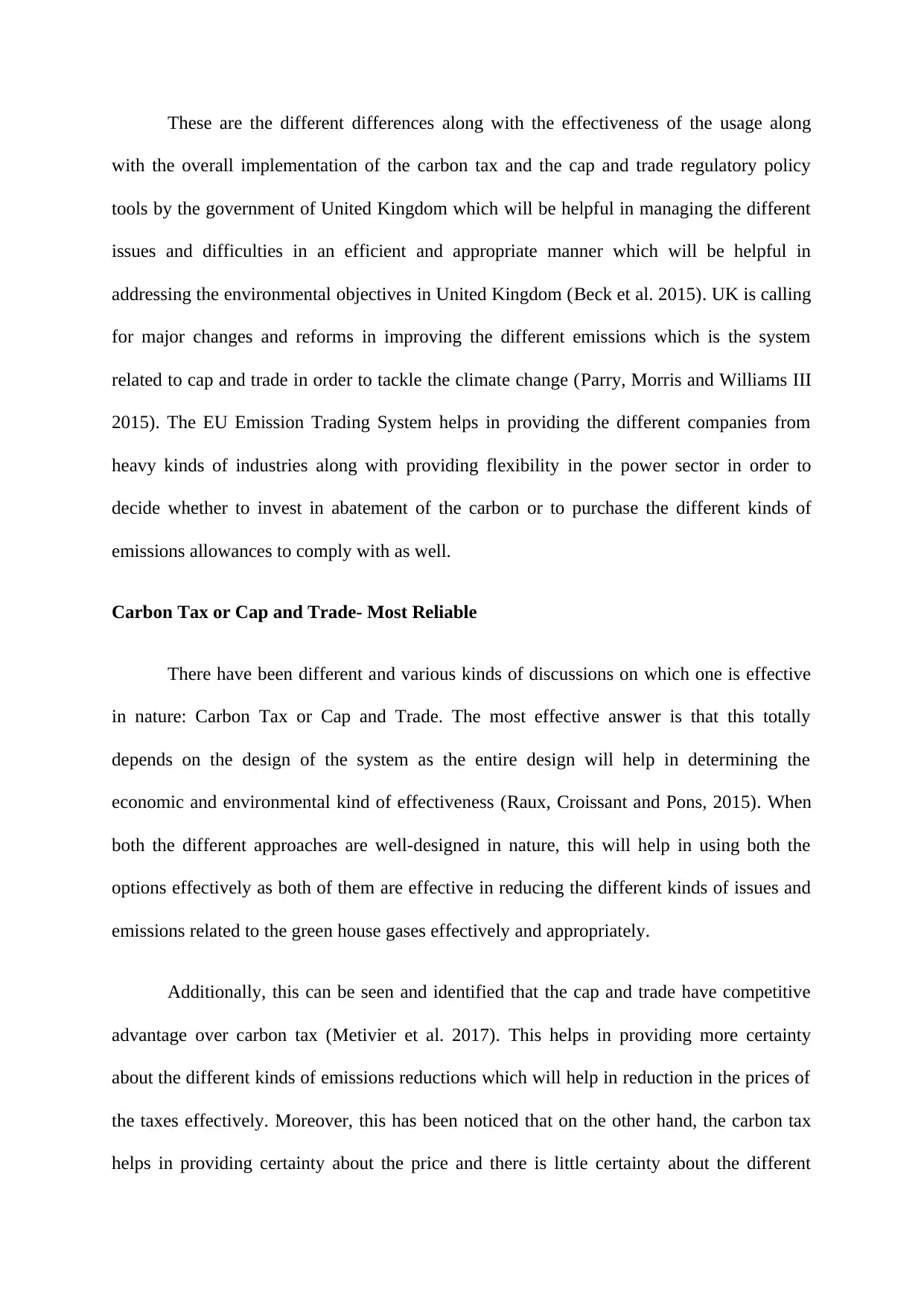
These are the different differences along with the effectiveness of the usage along
with the overall implementation of the carbon tax and the cap and trade regulatory policy
tools by the government of United Kingdom which will be helpful in managing the different
issues and difficulties in an efficient and appropriate manner which will be helpful in
addressing the environmental objectives in United Kingdom (Beck et al. 2015). UK is calling
for major changes and reforms in improving the different emissions which is the system
related to cap and trade in order to tackle the climate change (Parry, Morris and Williams III
2015). The EU Emission Trading System helps in providing the different companies from
heavy kinds of industries along with providing flexibility in the power sector in order to
decide whether to invest in abatement of the carbon or to purchase the different kinds of
emissions allowances to comply with as well.
Carbon Tax or Cap and Trade- Most Reliable
There have been different and various kinds of discussions on which one is effective
in nature: Carbon Tax or Cap and Trade. The most effective answer is that this totally
depends on the design of the system as the entire design will help in determining the
economic and environmental kind of effectiveness (Raux, Croissant and Pons, 2015). When
both the different approaches are well-designed in nature, this will help in using both the
options effectively as both of them are effective in reducing the different kinds of issues and
emissions related to the green house gases effectively and appropriately.
Additionally, this can be seen and identified that the cap and trade have competitive
advantage over carbon tax (Metivier et al. 2017). This helps in providing more certainty
about the different kinds of emissions reductions which will help in reduction in the prices of
the taxes effectively. Moreover, this has been noticed that on the other hand, the carbon tax
helps in providing certainty about the price and there is little certainty about the different
with the overall implementation of the carbon tax and the cap and trade regulatory policy
tools by the government of United Kingdom which will be helpful in managing the different
issues and difficulties in an efficient and appropriate manner which will be helpful in
addressing the environmental objectives in United Kingdom (Beck et al. 2015). UK is calling
for major changes and reforms in improving the different emissions which is the system
related to cap and trade in order to tackle the climate change (Parry, Morris and Williams III
2015). The EU Emission Trading System helps in providing the different companies from
heavy kinds of industries along with providing flexibility in the power sector in order to
decide whether to invest in abatement of the carbon or to purchase the different kinds of
emissions allowances to comply with as well.
Carbon Tax or Cap and Trade- Most Reliable
There have been different and various kinds of discussions on which one is effective
in nature: Carbon Tax or Cap and Trade. The most effective answer is that this totally
depends on the design of the system as the entire design will help in determining the
economic and environmental kind of effectiveness (Raux, Croissant and Pons, 2015). When
both the different approaches are well-designed in nature, this will help in using both the
options effectively as both of them are effective in reducing the different kinds of issues and
emissions related to the green house gases effectively and appropriately.
Additionally, this can be seen and identified that the cap and trade have competitive
advantage over carbon tax (Metivier et al. 2017). This helps in providing more certainty
about the different kinds of emissions reductions which will help in reduction in the prices of
the taxes effectively. Moreover, this has been noticed that on the other hand, the carbon tax
helps in providing certainty about the price and there is little certainty about the different
⊘ This is a preview!⊘
Do you want full access?
Subscribe today to unlock all pages.

Trusted by 1+ million students worldwide
1 out of 16
Related Documents
Your All-in-One AI-Powered Toolkit for Academic Success.
+13062052269
info@desklib.com
Available 24*7 on WhatsApp / Email
![[object Object]](/_next/static/media/star-bottom.7253800d.svg)
Unlock your academic potential
Copyright © 2020–2025 A2Z Services. All Rights Reserved. Developed and managed by ZUCOL.





